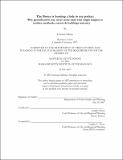| dc.contributor.advisor | Langley Keyes. | en_US |
| dc.contributor.author | Gelman, Emmaia | en_US |
| dc.contributor.other | Massachusetts Institute of Technology. Dept. of Urban Studies and Planning. | en_US |
| dc.date.accessioned | 2008-01-10T14:26:08Z | |
| dc.date.available | 2008-01-10T14:26:08Z | |
| dc.date.copyright | 2007 | en_US |
| dc.date.issued | 2007 | en_US |
| dc.identifier.uri | http://hdl.handle.net/1721.1/39850 | |
| dc.description | Thesis (M.C.P.)--Massachusetts Institute of Technology, Dept. of Urban Studies and Planning, 2007. | en_US |
| dc.description | This electronic version was submitted by the student author. The certified thesis is available in the Institute Archives and Special Collections. | en_US |
| dc.description | Includes bibliographical references (p. 114-119). | en_US |
| dc.description.abstract | Bronx buildings appear to face a split possibility for their future: gentrification, as the city housing market continues to tighten; or abandonment, as inflated prices come down and leave owners in the red. This thesis takes stock of the buildings, the players and regulation, and looks at what could happen and what should be happening in order for Bronx communities to build the capacity to plan for the future of the housing stock. In light of the new Bronx environment, the means of preserving and regulating housing stock necessarily look different than before. They demand a more comprehensive approach to regulation that reaches investors as well as physical buildings. They demand a physical monitoring system that doesn't bank on tenants to report or landlords to selfcertify, and that recognizes the social constraints on landlords and tenants as actors. Many of these gaps are bridged by community groups that can function as regulatory aides, advocates for both housing stock and property viability, and on-the-ground analysts of the shifting markets that coregulate Bronx buildings. | en_US |
| dc.description.statementofresponsibility | by Emmaia Gelman. | en_US |
| dc.format.extent | 124 p. | en_US |
| dc.language.iso | eng | en_US |
| dc.publisher | Massachusetts Institute of Technology | en_US |
| dc.rights | M.I.T. theses are protected by copyright. They may be viewed from this source for any purpose, but reproduction or distribution in any format is prohibited without written permission. See provided URL for inquiries about permission. | en_US |
| dc.rights.uri | http://dspace.mit.edu/handle/1721.1/7582 | |
| dc.subject | Urban Studies and Planning. | en_US |
| dc.title | The Bronx is burning a hole in my pocket : why gentrification may never come (and what might happen to lenders, landlords, renters & buildings instead.) | en_US |
| dc.type | Thesis | en_US |
| dc.description.degree | M.C.P. | en_US |
| dc.contributor.department | Massachusetts Institute of Technology. Department of Urban Studies and Planning | |
| dc.identifier.oclc | 182835469 | en_US |
